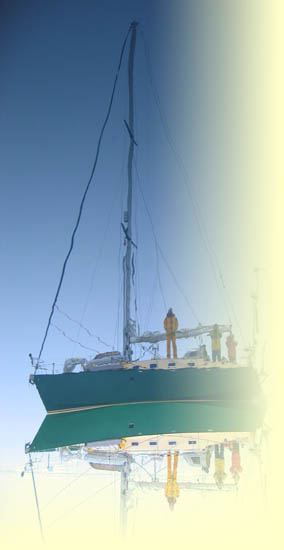

The Northwest Passage is composed of a complex series of waterways in the High Arctic spanning the entire North American Continent from the Pacific to the Atlantic Ocean. For the most part, the route is frozen solid and is impenetrable by all save the largest icebreakers. However, during the brief Arctic summer, the ice sometimes recedes enough to allow a small craft through.
For centuries men have struggled and many died trying to forge a way through this hostile environment in order to establish an alternative trading route for spices and goods from the East. Probably the most famous and harrowing account of all being that of the British Naval Officer, Sir John Franklin. His ships 'Erebus' and 'Terror' were lost to the ice in 1847 along with all hands. They had endured 3 tortuous years of starvation and disease beset in the pack ice. Today many of the sounds and straits still bear Franklin's name as well as those of his Officers and men.
It wasn't until 1906 that finally, after many others had tried and failed, the Norwegian explorer Roald Amundsen in his 47 tonne sloop 'Gjoa' emerged in the Pacific to become the first yacht to complete the Northwest Passage. It took Amundsen three winters to complete the voyage, two of which were spent in what is now called Gjoa Haven where he carried out scientific studies on the magnetic North Pole.
Nobody was to complete this journey again until 1942 when the Canadian ship 'St Roch' and its captain Henry Larsen made the second complete transit and the first from West to East. Larsen didn't just call it a day there though, he then turned round and went back through the other way!
In 1977 the Belgian sailor Willy de Roos and his steel ketch 'Willywaw' became the 3rd yacht to go through, largely single handed.
To date (2003), only 20 yachts have ever completed the NWP, of these 14 made it through in one season, and fewer than 10 (including 'Norwegian Blue'), without ice breaker assistance.
The first and until now, only British yacht to have completed the Passage was Rick Thomas' 'Northanger'. He sailed her East to West, overwintering in Inuvik in 1988. He was closely followed by David Scott Cowper in his converted British lifeboat 'Mabel E Holland'. It took David 4 seasons to complete his transit, having suffered three consecutive bad ice years.
On 18 July 2003, father and son team, Richard & Andrew Wood with Zoe Birchenough sailed 'Norwegian Blue' into the Bering Strait which marks the entrance to the NWP. Exactly two months later, in what proved to be a very difficult ice year and without ice breaker assistance, she sailed into the Davis Strait to become the first British yacht to transit the Northwest Passage from West to East. She also became the only British vessel to have completed the Northwest Passage in one season.
The 'Norwegian Blue' crew were happy to have spent the last few weeks of their time on ice in the company of Eric Brossier's 'Vagabond' and his fantastic crew. Of a record seven attempts at the NWP in 2003, 'Vagabond' & 'Norwegian Blue' were the only two yachts to successfully complete their transit. Both were fortunate enough to have been in the right place for the one day of the year the ice opened in Larsen Sound & Franklin Strait, traditionally the most difficult part of the NWP.
On 10 October 2003, having set out from New Zealand only five months earlier, Zoe & Andrew sailed 'Norwegian Blue' into St Mary's Harbour in the Isles of Scilly, having covered over half the globe via one of the world's most challenging and difficult sea routes... The Northwest Passage.